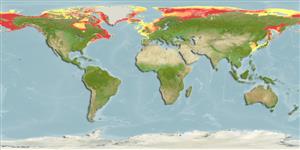Common names from other countries
Classification / Names / Names
Nomi Comuni | Sinonimi | Catalog of Fishes (gen., sp.) | ITIS | CoL | WoRMS
Environment: milieu / climate zone / depth range / distribution range
Ecologia
Batidemersale. Temperate; 90°N - 0°S, 180°W - 180°E
Pacific Northwest, Pacific Ocean, Atlantic Ocean and the Arctic: Bering Sea, Sea of Okhotsk, Atlantic Ocean, Canada Quebec, Alaska, Greenland, Canada Newfoundland, Norway, Russia, Japan (Ref. 1394), Canada, Iceland, UK, France, Spain, Portugal, China, Kamchatka, Laptev Sea (Ref. 1522); Erignathus barbatus barbatus: Canada, Greenland, Russia, Canada Newfoundland, Iceland, Norway, UK, France, Spain, Portugal; Erignathus barbatus nauticus: Russia, Canada, Laptev Sea, Alaska, Japan, China, Sea of Okhotsk, Kamchatka.
Length at first maturity / Size / Peso / Age
Maturity: Lm ? range ? - ? cm Max length : 250 cm TL maschio/sesso non determinato; (Ref. 1394)
They usually restrict themselves to sea ice and stay in relatively shallow areas of continuously moving ice, where open leads and polynyas regularly form. In some areas, they are known to haul out on shore, ascend streams, or live a pelagic existence away from ice and land for long periods of time. Feeds on many species of small invertebrates that live on, and in, the bottom; and fish (Ref. 1394). They usually restrict themselves to sea ice and stay in relatively shallow areas of continuously moving ice, where open leads and polynyas regularly form. In some areas, they are known to haul out on shore, ascend streams, or live a pelagic existence away from ice and land for long periods of time. Feeds on many species of small invertebrates that live on, and in, the bottom; fish (Ref. 1394).
Jefferson, T.A., S. Leatherwood and M.A. Webber. 1993. (Ref. 1394)
IUCN Red List Status (Ref. 130435)
CITES status (Ref. 108899)
Not Evaluated
Not Evaluated
Human uses
Pesca: commerciale
FAO - pesca: landings, species profile | FishSource | Sea Around Us
Strumenti
Fonti Internet
Estimates based on models
Preferred temperature
(Ref.
115969): -1.7 - 8.9, mean 0.5 (based on 6792 cells).
Resilienza
Medio, tempo minimo di raddoppiamento della popolazione 1.4 - 4.4 anni (K=0.18-0.29).
Vulnerability
Moderate to high vulnerability (55 of 100).
Price category
Unknown.
